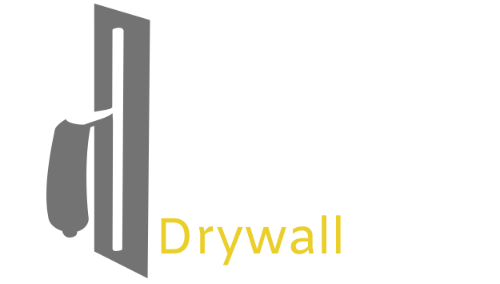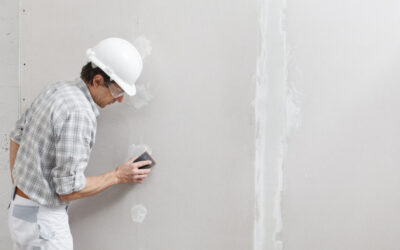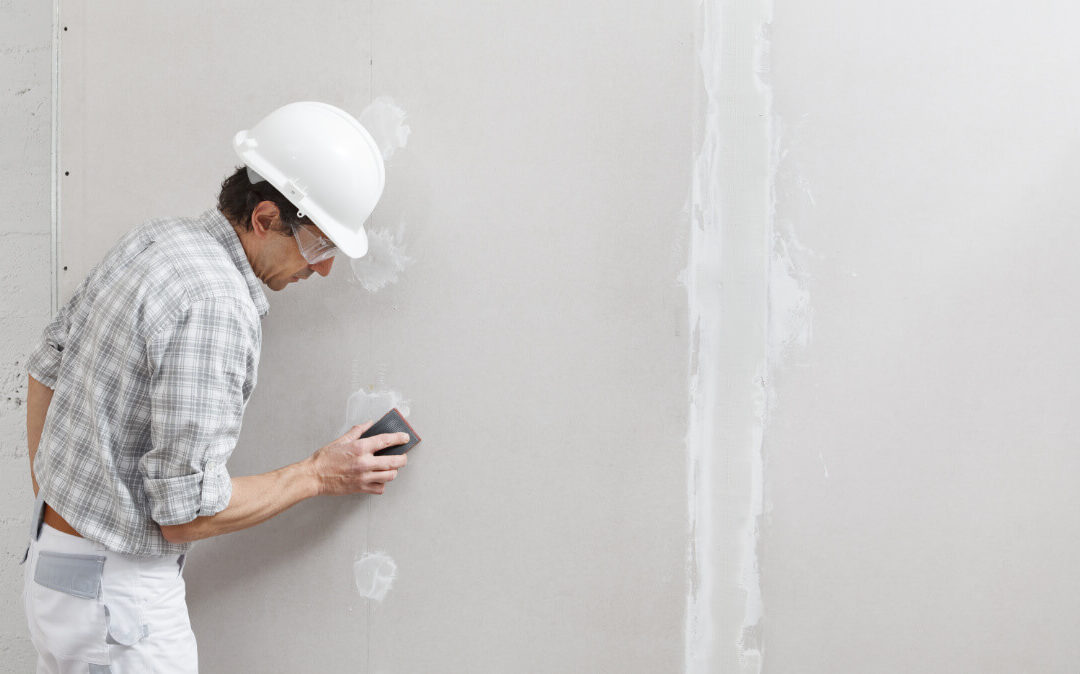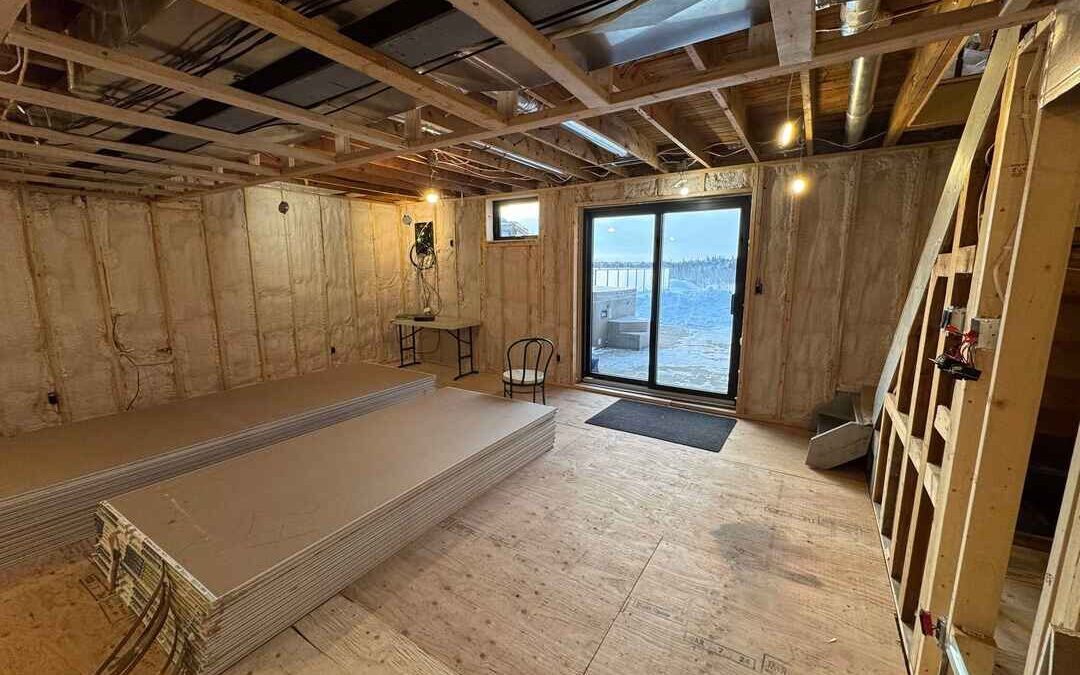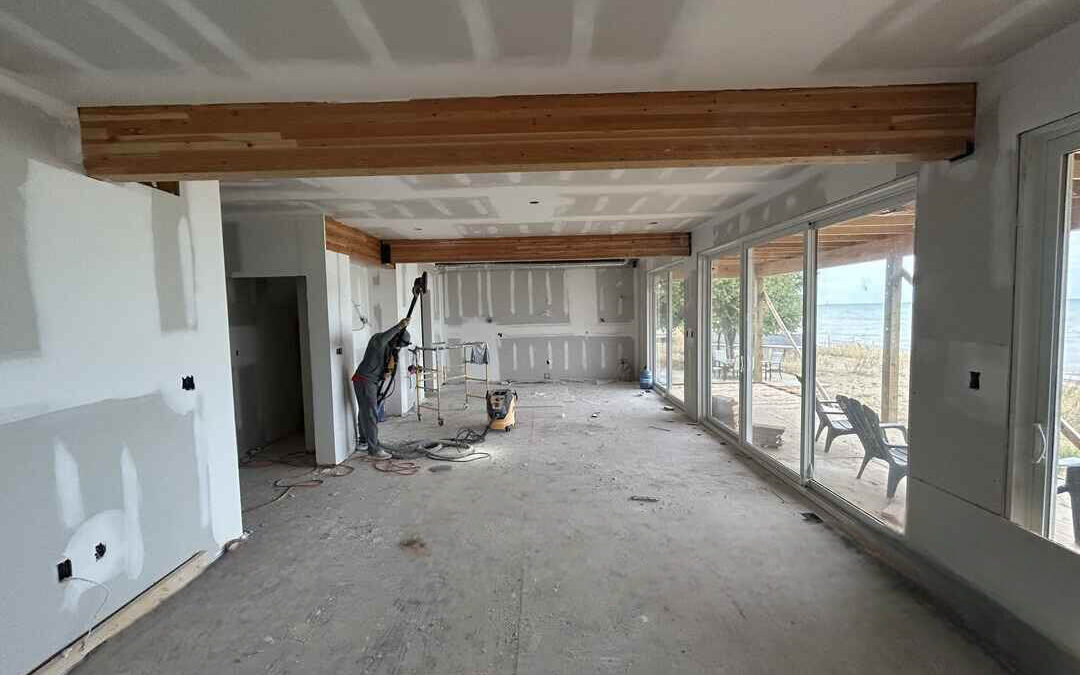You are rearranging furniture then bam! A table leg bumps the wall, leaving an unsightly dent. Or maybe you remove an old picture frame, only to find a gaping hole from a misplaced hook. Cracks can even appear out of nowhere, making your walls look aged and worn. The first thought is always the same. How much will this cost to fix? The answer is not always simple. Repairs can range from a quick DIY patch to a more professional job. This guide will break down drywall repair costs, helping you understand what affects pricing and your best options.
The Big Picture: What’s the Average Cost of Drywall Repair?
Drywall repair costs depend on many factors, including the type of damage, the materials needed, and the job’s complexity. Some repairs are straightforward, while others require more effort, especially if the wall has water damage or cracks that keep coming back. Every repair is different, which is why prices can vary so much.
Small holes and dents often require minimal work, while large repairs may require more time and expertise. Location also matters. A patch in an open space is easier to fix than damage near a ceiling or corner. Some walls need extra finishing to blend the repair with the surrounding surface.
General cost estimates exist, but every home is unique. Consulting a professional can give a clearer idea of what to expect. Understanding what influences pricing helps homeowners decide the best approach for their drywall repairs.
Related: Drywall installation cost
Breaking Down the Costs: What Factors Influence the Final Price?
Understanding the factors that influence drywall repair costs is key to estimating what a homeowner might expect to spend. No two repairs are exactly alike. Some involve simple patches, while others require more extensive fixes, especially if there are underlying issues like water damage or structural concerns. Everything from the size of the damage to the location of the repair can impact the overall cost.
The Size and Scope of the Damage
The area that needs repair plays a big role in determining the cost. Small patches require minimal materials and labor, while large sections take more time and effort.
- Small Patches: Minor holes from picture hooks, nail pops, or tiny dents can often be repaired quickly with minimal materials.
- Large Replacements: Bigger damage, like holes from doorknobs, furniture impacts, or accidents, may require full panel replacements, additional joint compound, sanding, and repainting.
Repairs that involve an entire wall or multiple areas naturally require more materials and labor, which increases the overall cost.
The Type of Drywall Damage
Different types of drywall damage require different repair techniques. Some issues are surface-level and easy to fix, while others need more extensive work.
1. Small Holes
Nail pops, screws, and small picture hook holes are the easiest repairs. Spackle or joint compound is applied, smoothed out, and then sanded before painting. This is a quick fix that many homeowners can handle on their own.
2. Large Holes
Accidental impacts, such as a doorknob punching through the wall, require more effort. Patching these areas often involves cutting out damaged drywall, additing a backing piece, applying a patch, and sealing it with joint compound and tape.
3. Cracks
Cracks come in different forms and can indicate different problems.
- Hairline Cracks: These are often caused by settling and can be patched easily with joint compound.
- Stress Cracks: These may appear near windows, doors, or ceilings and can indicate shifting in the home’s structure. Reinforcement with fiberglass tape may be necessary to prevent the crack from returning.
- Corner Cracks: These require extra precision because they involve the drywal’s structural edges. Special corner tape or beads may be used to ensure a smooth finish.
4. Dents
Furniture bumping against the wall often results in dents. These minor imperfections can usually be filled with joint compound, sanded, and repainted.
5. Tears
Peeling drywall paper can occur when removing wallpaper or tape. This can be tricky to fix, as applying joint compound directly to torn paper can cause bubbling. A primer is often needed before applying compound.
6. Water Damage
Water exposure weakens drywall and can lead to mold growth if left untreated. This type of damage often requires cutting out the affected area, replacing insulation if necessary, and ensuring the source of moisture has been addressed before repairing the drywall.
7. Ceiling Damage
Fixing ceiling drywall is more challenging than wall repairs. The height and angle require additional equipment like ladders and scaffolding. Sagging or damaged ceilings may need full panel replacements, which increases labor time and material use.
The Complexity and Location of the Repair
Some drywall repairs are straightforward, while others present challenges due to where they are located.
- Hard-to-Reach Areas: Ceilings, high walls, and tight corners require extra effort and tools.
- Repairs Near Fixtures: If damage is around electrical outlets, plumbing, or light fixtures, extra caution is needed. Sometimes, power must be turned off or pipes inspected before proceeding.
These factors can increase labor time and the overall cost of the repair.
Materials Used
Drywall repair requires specific materials, and the type and quantity can impact the cost.
DIY vs. Professional Material Supply
Homeowners can choose to buy materials themselves, but professionals often bring their own, which may increase the price slightly. However, having an expert handle the process ensures the right products are used for a seamless repair.
Do you need professional help with residential drywall installation or commercial drywall installation? Hire Grey County Drywall Contractor – your local drywall expert!
Labor Costs: DIY vs. Hiring a Professional
Deciding whether to do the repair yourself or hire a professional depends on the size and complexity of the job.
DIY Repairs
- Suitable for small holes, nail pops, and minor dents.
- Requires basic tools like spackle, a putty knife, and sandpaper.
- Takes time and patience to achieve a smooth finish.
Hiring a Drywall Contractor
- Best for large holes, extensive cracks, water damage, or ceiling repairs.
- Ensures the repair blends seamlessly with the existing wall.
- More expensive but provides high-quality results.
DIY vs. Professional Repair Comparison
Geographic Location
Labor and material costs are not the same everywhere. Some areas have higher labor rates due to demand, while others may have lower costs. Availability of materials can also influence pricing.
Potential Hidden Costs
Sometimes, drywall repair reveals other underlying issues that need attention.
- Mold and Water Damage: If moisture has been trapped behind the drywall, mold may need to be treated before repairs can begin.
- Structural Issues: Some cracks indicate foundation movement, which may require additional inspection and reinforcement.
- Painting and Texture Matching: Repairs that require repainting or retexturing add to the overall cost. Ensuring the new patch blends with the surrounding wall takes time and expertise.
Making the Right Choice
Each drywall repair situation is different. Some small issues can be handled with DIY methods, while others require a professional’s touch. Understanding what influences the cost can help homeowners make the best decision for their needs.
If the damage is extensive or in a difficult location, consulting a drywall expert can ensure a smooth and long-lasting repair.
A Deep Dive into Drywall Repair Costs
Drywall repairs can come in all shapes and sizes, and the costs involved can vary greatly. Understanding the general cost ranges for various types of drywall repairs can help you plan for your project, whether you choose to tackle it yourself or bring in a professional.
1. Patching Holes
Patching holes in drywall is one of the most common repairs, and the cost can vary depending on the size of the hole and whether you do it yourself or hire a professional.
Small Holes
Small holes caused by nails or screws are relatively simple to patch. Most DIY enthusiasts can handle this with a basic repair kit available at home improvement stores.
- DIY Cost: Generally, small hole patch kits are affordable and easy to use, and you can get them at the local Home Depot.
- Professional Cost: Hiring a professional for a small hole repair typically falls within a reasonable range.
Medium Holes
Medium-sized holes may require a more involved repair process, including cutting and replacing a section of drywall. This type of repair may also require additional materials such as joint compound and drywall tape.
- DIY Cost: The cost for materials to patch a medium hole can be manageable.
- Professional Cost: If you choose to hire a pro, the cost will increase slightly due to the additional labor and materials involved.
Large Holes
Large holes caused by significant impact often require a complete drywall replacement and a more detailed process. This repair can be more involved, especially if there is a need to replace insulation or structural elements.
- DIY Cost: Materials for large hole repairs may add up, but it is doable for experienced DIYers.
- Professional Cost: Professional services are typically higher for large repairs due to the labor-intensive nature of the task.
Professional Drywall Repair Cost Estimates
2. Repairing Cracks
Cracks can form in drywall for several reasons, including settling of the house or natural wear and tear. The cost to repair cracks depends on their size and whether there are underlying issues contributing to the crack.
Hairline Cracks
These tiny cracks are the least expensive to repair, often requiring just some joint compound and a little time to fill them in and smooth them over.
- DIY Cost: This repair is typically inexpensive and can be done with basic materials that you can get at the local Home Depot.
- Professional Cost: Cracks of this size are often handled quickly by professionals, and their rates are usually quite reasonable.
Medium Cracks
Cracks of a medium size may need a bit more attention. Often, these cracks require joint tape, compound, and additional sanding to blend in seamlessly with the surrounding drywall.
- DIY Cost: The cost for medium cracks is still fairly low but may require a bit more time to complete.
- Professional Cost: For medium cracks, professionals may charge more due to the extra time and care required.
Large Cracks
Larger cracks, especially those that extend beyond a few inches, may indicate structural issues and will likely require a more thorough repair. Addressing these cracks might involve replacing drywall sections, applying joint tape, and sometimes even addressing underlying structural issues.
- DIY Cost: Larger cracks may require more advanced materials, but it’s still possible for experienced DIYers to handle them.
- Professional Cost: Due to the potential complexity and underlying issues, professional repair costs tend to be higher.
3. Fixing Dents and Tears
Dents and tears are common issues, especially in high-traffic areas. The cost of fixing these damages can vary depending on their size and severity.
Small Dents and Tears
Minor dents and tears are often quick fixes. Joint compound is usually all that’s needed for small repairs, making it an easy DIY project.
- DIY Cost: Very affordable for most homeowners.
- Professional Cost: Professionals can handle small dents and tears at a low cost due to the simplicity of the job.
Larger Dents and Tears
For more significant damage, such as a large dent or tear, you might need to replace a portion of the drywall. This could involve cutting out the damaged section and patching it with new drywall.
- DIY Cost: The cost of materials may increase with larger repairs, but it’s manageable for a skilled DIYer.
- Professional Cost: Repairing larger dents or tears is a bit more involved, which may lead to higher professional fees.
4. Addressing Nail Pops
Nail pops occur when the nails or screws used to attach the drywall to the studs push through the surface, creating small bulges. This is a relatively simple repair that requires little more than replacing the nails or screws and patching the surface.
- DIY Cost: Nail pop repairs are affordable and easy to handle with minimal materials.
- Professional Cost: Professionals usually charge a reasonable fee for nail pop repairs due to their simplicity.
5. Water Damage Repair
Water damage is often the most expensive type of drywall repair. If water has caused significant damage, the repair may involve replacing the drywall, dealing with mold remediation, and fixing the source of the leak. This is a more complicated process, as it often requires multiple steps and additional work like replacing insulation or addressing plumbing issues.
Water Damage Repair
The cost of water damage repair can vary significantly based on the extent of the damage and whether the repair also involves mold remediation. If you’re only replacing a section of drywall, the cost may be on the lower end of the spectrum. However, if mold has spread or there is structural damage, costs can rise.
- DIY Cost: If it’s just a small area and no mold is present, the cost can be relatively low.
- Professional Cost: Due to the potential complexity of water damage repair, professional services can be more expensive, especially if mold or insulation needs to be replaced.
When repairing water damage, it’s crucial to first address the source of the leak before starting drywall repairs. Failing to do so can lead to recurring damage and increased repair costs.
6. Ceiling Repair
Ceiling repairs tend to be more expensive than wall repairs due to the difficulty of working overhead and the potential safety risks involved. The types of issues that commonly affect ceilings include cracks, holes, and sagging drywall.
Common Ceiling Issues
Ceiling damage can often require more effort due to the height involved. It might also require the use of scaffolding or ladders. In cases of sagging ceilings, structural repairs could be necessary, increasing the cost.
- DIY Cost: Repairing small ceiling issues yourself may still be affordable, but costs increase with larger repairs.
- Professional Cost: Professionals typically charge more for ceiling repairs, especially if it involves structural concerns or difficult access.
DIY or Call a Pro? Making the Right Decision
Choosing between tackling a drywall repair yourself or hiring a professional depends on the damage and your confidence level. Here are some guidelines to help you decide:
When DIY Might Be Okay:
- Small, superficial damage (nail holes, minor dents).
- You have some DIY experience and feel comfortable.
- The repair is in a low-visibility area.
- You have the necessary tools and materials.
DIY Drywall Repair Kits cost
**These products can be bought at local Home Depot. These prices were updated on April 11, 2025. Check their website for up-to-date prices.
When Hiring a Professional is Recommended:
- Large holes or extensive damage.
- Ceiling repairs that require working overhead.
- Water damage or potential mold that requires specialized treatment.
- Repairs in highly visible areas where a flawless finish is desired.
- Corner or complex repairs (e.g., repairing corner beads).
- You lack the time, tools, or confidence to DIY.
- Potential underlying issues, such as structural cracks.
If you decide to hire a professional, always check reviews, verify credentials, and gather multiple quotes. This ensures you’re working with someone trustworthy and helps you get the best value for your money.
Frequently Asked Questions
1. How much does it cost to repair drywall?
The cost to repair drywall can vary depending on the extent of the damage and whether you’re handling it yourself or hiring a professional. For small repairs like holes or dents, the cost can be relatively low, but larger issues, such as extensive cracks or water damage, will be more expensive. Typically, homeowners might spend anywhere from a few dollars for a DIY fix to several hundred dollars for professional repairs.
2. How much does it cost to mud and tape drywall in Canada?
Mudding and taping drywall is an essential part of the installation process, helping to create a smooth surface for painting. Costs can vary depending on the complexity of the job and the size of the area being worked on. Generally, you can expect a range per square foot, which will vary by region and contractor.
3. How much does it cost to hang drywall in 500 square feet?
Hanging drywall in a 500-square-foot area involves both material costs and labor. While costs fluctuate based on factors like location and the drywall type, the price will often fall within a range per square foot. Keep in mind that this doesn’t include additional services such as mudding and taping.
4. What is the average labor cost to replace drywall?
Labor costs for drywall replacement depend on the scope of the project. For simple repairs, labor might be minimal, but for a full replacement, the cost could increase significantly. As always, it’s helpful to get multiple quotes and consider any additional costs for materials and tools.
